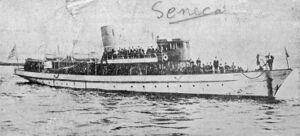Engineering:USS Seneca (SP-427)

| |
| History | |
|---|---|
| Name: |
|
| Namesake: |
|
| Completed: | 1888 |
| Acquired: | 7 May 1917 |
| Commissioned: | 18 July 1917 |
| Decommissioned: | 2 January 1919 |
| Struck: | 6 January 1919 |
| Fate: | Returned to owner 6 January 1919 |
| Notes: | Operated as civilian yacht Seneca until 1917 and from 1919 |
| General characteristics | |
| Type: | Minesweeper and patrol vessel |
| Tonnage: | 157 gross register tons |
| Length: | 150 ft (46 m) |
| Beam: | 20 ft (6.1 m) |
| Draft: | 10 ft 6 in (3.20 m) |
| Propulsion: | Steam engine |
| Speed: | 18 knots |
| Complement: | 33 |
| Armament: | 2 × 6-pounder guns |
The third USS Seneca (SP-427), later USS SP-427, was a United States Navy minesweeper and patrol vessel in commission from 1917 to 1919.
Seneca was built as a civilian steam yacht in 1888 at Boston, Massachusetts . On 7 May 1917, the U.S. Navy acquired her from her owner, the Johnson Lighterage Company, for use as a minesweeper and patrol vessel on the section patrol during World War I. She was commissioned as USS Seneca (SP-427) on 17 July 1917.
Based at Tompkinsville, Staten Island, New York, Seneca carried out minesweeping and patrol duties for the rest of World War I. In 1918, she was renamed USS SP-427.
SP-427 was decommissioned on 2 January 1919. She was stricken from the Navy List on 6 January 1919 and returned to Johnson Lighterage the same day.
Seneca (SP-427) should not be confused the barge USS Seneca (SP-1240), which was in commission at the same time.
References
- This article incorporates text from the public domain Dictionary of American Naval Fighting Ships. The entry can be found here.
- Department of the Navy Naval History and Heritage Command Online Library of Selected Images: Civilian Ships: Seneca (Steam Yacht, 1888). Served as USS Seneca (SP-427) and USS SP-427 in 1917-1919
- NavSource Online: Section Patrol Craft Photo Archive: SP-427 ex-Seneca (SP 427)
 |

